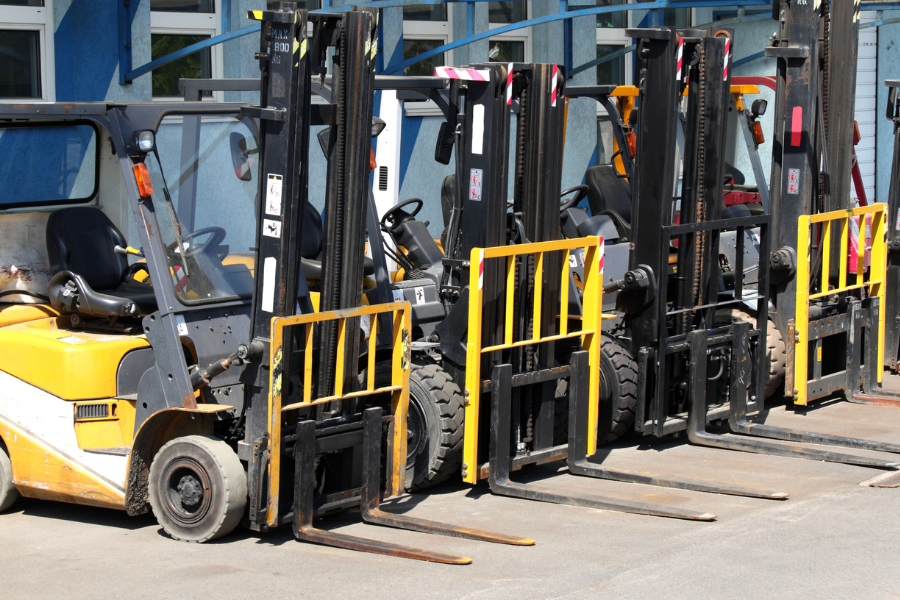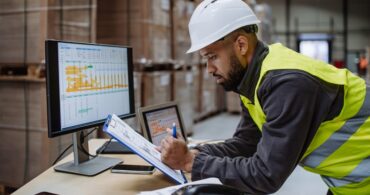Most forklifts require a specific type of tire, either solid cushion forklift tires or pneumatic tires. Selecting the right style for your fleet will ensure their performance and maintain the safety of your employees.
When buying a new (or used) forklift, there are many factors to consider, such as lifting capacity, carriage type, price, etc. However, you can’t overlook the importance of your forklift’s tires. Several factors impact which tire is correct for your forklifts, including:
- Whether they operate indoors or outdoors.
- The job environment, such as a warehouse with narrow aisles, cold storage, etc.
- Surface type, i.e., rough, smooth, concrete, asphalt, gravel, grass, etc.
- Typical cargo.
- Necessary turning radius.
- Potential for puncture.
There are two common forklift tires: solid cushion and pneumatic.
Rubber cushion tire forklift
There is one significant difference between a solid cushion wheel and the tires most people know: cushion tires are made of solid rubber.
Solid cushion tires for forklifts are comprised of a single piece of thick, solid rubber wrapped around a metal band. Most cushion tires are smooth; however, there are forklift cushion traction tires that are manufactured with tread. The main benefit of solid cushion tires is that they cannot be punctured. With solid tires, you can run over as many nails and glass shards as you want and never miss a beat (however, don’t do that).
So, why are we wasting time putting air in the tires on our cars? Well, if you were to slap some solid cushion tires on your Toyota and tootle on down the road, the first pothole you hit might jar the teeth out of your mouth. The term “cushion” is a bit generous as these tires have little to no shock absorption. That’s why forklifts that utilize cushion tires are typically used indoors and on smooth surfaces.
The benefits of cushion tire forklifts include:
- Inexpensive to manufacture, purchase and maintain.
- Durable and cost-effective, allowing for a long lifespan.
- Impervious to punctures.
- Handle better in tight spaces because they run low to the ground.
- Narrow turn radius because a cushion tire’s smooth surface provides less “grip” on the floor.
Some drawbacks of cushion tires:
- Poor traction in most outdoor environments.
- Need a smooth surface, or it’s going to be a bumpy ride.
Forklift with pneumatic tires
Most people are already familiar with pneumatic wheels, although they just call them “tires.” Pneumatic tires are used on most passenger cars and commercial vehicles you see (and likely operate) daily.
The term pneumatic describes something that functions using pressurized air or gas, like nitrogen. For example, another term for a jackhammer is pneumatic drill because it uses compressed air to quickly move a heavy metal piece up and down to blast cement apart.
The outside of a pneumatic tire features thick tread-molded rubber typically reinforced by steel belting. Layers of rubber-coated polyester, known as “plies,” are found underneath the rubber. The inside of the tire is an airtight core. A pneumatic tire can function only when that airtight core is filled with air. In fact, you can always spot a pneumatic tire by looking for the air valve. Solid cushion tires for forklifts do not need a valve.
What’s truly impressive about pneumatic tires is they remain inflated even when the weight of several tons of vehicle bears down on them. This happens, in short, because the air pressure inside the tire is greater than the air pressure outside of it. As the inside pressure pushes outward, it keeps the tire rigid and stable. That’s why the tire sags when the pressure is too low.
The benefits of pneumatic tires include:
- Ideal for outdoor environments, job sites with uneven terrains and pothole-riddled areas.
- Provide a comfortable ride because they have exceptional shock absorption.
- Deliver a firm grip on uneven surfaces.
- A large width, which provides more stability.
- Wide variety of available tread patterns makes them adaptable to a variety of environments and conditions.
Some drawbacks of pneumatic tires:
- Typically cost more than cushion tires and have a shorter lifespan.
- Prone to punctures.
What is a pneumatic forklift cushion wheel?
This frequently searched phrase illustrates an important point about cushion vs pneumatic forklift tires: they can be confusing, and there’s a second type of “pneumatic” tire that doesn’t help the situation.
When searching for tires, you may see a product described as a “solid pneumatic tire” or a “pneumatic forklift cushion wheel.” These terms describe a tire that’s designed in layers similar to a pneumatic tire. However, instead of an open, airtight core, these tires have a solid core.
Hey, the world is full of wonderous, confounding things. Tomatoes are a fruit. Camels have three eyelids. So, if the industry wants to say it has a “solid pneumatic tire,” fine. It has a “solid pneumatic tire.” However, we all now know that—no matter how it’s designed and manufactured—calling something a “solid pneumatic tire” is inaccurate. Tires are either solid or pneumatic, i.e., filled with pressurized air. They can’t be both.
Signs that a cushion or pneumatic tire needs to be replaced
Running a forklift on worn or damaged tires risks harming the equipment and seriously injuring the forklift operator or other workers.
Many forklift tires have a wear indicator bar molded into the side of the tire. This indicator is only visible once the rubber begins to thin. Once the indicator bar appears, it’s time to purchase a new tire.
Other signs that a tire needs to be replaced include:
- Damage to the tire, such as tears, missing pieces, splits, cracks and flat areas.
- Noticeably uncomfortable rides.
- Lower forklift ground clearance.
- Reduced lifting height.
At Texas Motive Solutions, we take the safety of your forklift fleet very seriously, from the bottoms of your tires to the tips of the mast. Naturally, we’re especially concerned with the durability and viability of your fleet’s batteries. For all your forklift battery and forklift battery repair needs, please give us a call at (888) 316-2459 or fill out a form to learn about our services and discover everything we can do fo



